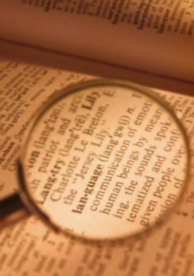Wordplay is a regular column by editor and language writer James Harbeck in which he tastes and plays with English words and usages.
Here it is:
Did you like it? I hope you didn’t blink and miss it.
Do you object that there’s nothing to be seen? You should avoid such blanket statements. It may look like a blanket of snow, but consider that a blanket of snow is not nothing, but a version of everything. It is made of millions of snowflakes, a compendium of hexagonal geometries; each one is its own crystalline shape, reflecting back all the wavelengths of light that hit it. White is not an absence of colour, after all; it is a surfeit of colours, too many to choose from, all of them all at once.
And that is what blank is: white. French, blanc. Every blank thing comes from this original whiteness, mistaken for emptiness. Let there be white. A blanket? Originally fabric made from loose undyed wool. Even blink is related: the common source is a root meaning “shine.”
Shine? How about glisten? Latin, candere, “glisten,” also meaning “be white.” The white sheet is candid in its incandescence. It glows frankly, presenting itself as a candidate for your expression. A blank block of stone invites the sculptor to chip away those parts that are not the final sculpture. A blank screen or sheet of paper invites the writer to remove the white selectively with ink. The communication comes from the ablation of white: take away potential, and you have meaning. You can only gain through the loss, the loss of gloss to make use of your glossary.
Words are not the only things that fill blank spaces, of course. Print a photo: put the colours on the blank white paper, using the inks to filter out this and that colour of light so that you can see shapes. And then put it in an album. Album? In Latin, album means “blank slate” or “notice board”; albus means “white.”
We always feel that a blank needs to be filled in. We cannot confront the sheer emptiness, which is actually the sheer fullness from which we need to remove some light in order to shed light on our topics. But a blank to be filled in is not purely . It is a question asked directly, using a straight line. And a straight line is what characterizes point blank: the distance at which a fired projectile will go straight to the point. What point? The blank, the bull’s eye in the middle of the target. Projectiles exhibit declivity due to gravity over distance, but if you set your sights on the target, and the bullet does not perceptibly deflect downward but seems to follow a straight line _________ , you are still within point-blank range. However, if you shoot a blank, you will never get to the point at all. So you give it your best shot.
A white sheet can be striking. Whiteness has many meanings and many effects as Herman Melville told us when he wrote of “the whiteness of the whale” in Moby-Dick. It is too many things; it is everything and so it is nothing, and so we must hunt it to eliminate it, we must strike at it. What do you get when you strike a blank? Why, a coin, of course. By removing potential, you make money. You can’t take blank to the bank; a blank cheque must be filled in. The variables must become constant: n equals what?
You must calm the blank. What makes things white? The million snowflakes, yes: a jumble. A smooth pane of glass is clear; rough up its surface and you get white, all the light from beyond, tumbled out of order. Take some oil, nice and clear, and put it in some water, nice and clear. Now run them in a blender, and you will get a milky white mixture. That’s what makes milk white: it’s an emulsion, fat roughed up, shattered in water. And what is white water? The most turbulent, the least static. You thread through it with your canoe, or kayak, or raft, making a path to safety, if you may. The fear of the blank is not a fear of a placid nothing; it is a fear of an implacable everything.
Blank starts with a question, just as Mel Blanc (born Melvin Blank), voice of moving drawings, once asked: “What’s up, doc?” So your doc says, “What’s up?” You endeavor to put something down on paper, to fill it, but you must always leave some blank, for if the variable n becomes constant, filled with carbon, C (c is also the speed at which light escapes), and blank becomes black, what you have written cannot be read. So at a point, you stop. And to your remaining blank, Blanc says, “That’s all, folks.”
James Harbeck is a web editor, print designer, and trained linguist. Read his blog at sesquiotic.wordpress.com and articles at TheWeek.com.
This article was copy edited by Whitney Matusiak.

